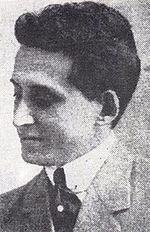
Adolfo Colombo
Encyclopedia

Colombo was a tenor, who sang regularly with Claudio García (baritone) in the theatre and on recordings. He also recorded with Regino López and other artists between 1906 to 1929. In 1908 he joined the Cuarteto Villalón with García, Emilio Reinoso (mandolin), and Alberto Villalón
Alberto Villalón
Alberto Villalón Morales was one of the greatest musicians in the Cuban trova style....
(guitar). This was an early precursor of the son groups that developed later in Havana. Their repertoire included bolero
Bolero
Bolero is a form of slow-tempo Latin music and its associated dance and song. There are Spanish and Cuban forms which are both significant and which have separate origins.The term is also used for some art music...
s and other Cuban genres such as guaracha
Guaracha
The guaracha is a genre of Cuban popular music, of rapid tempo and with lyrics. The word had been used in this sense at least since the late 18th and early 19th century. Guarachas were played and sung in musical theatres and in low-class dance salons. They became an integral part of Bufo comic...
s, a genre which owed its origin to the theatre. One that has been reissued by Harlequin reveals a funky number which is hard to categorize. Listed as a rumba
Rumba
Rumba is a family of percussive rhythms, song and dance that originated in Cuba as a combination of the musical traditions of Africans brought to Cuba as slaves and Spanish colonizers. The name derives from the Cuban Spanish word rumbo which means "party" or "spree". It is secular, with no...
, it is perhaps better described as a guaracha-son. The artists singing are Colombo and Claudio García, the guitar probably Alberto Villalón
Alberto Villalón
Alberto Villalón Morales was one of the greatest musicians in the Cuban trova style....
, plus an unknown musician playing what may be a tres guitar; there is also a clavé
Clavé
Clavé is a commune in the Deux-Sèvres department in the Poitou-Charentes region in western France.-References:*...
. All three named players were white, yet the number is creole, almost Afro-Cuban, in style. Mamá Teresa is still quite well known today in Cuba, and has been recorded by many other groups:
- Mamá Teresa se va...
- Mamá Teresa se va...
- Porque no quiere bailar la rumba
- Con Juan que tiene la pata gamba
-
- (Mama Teresa's leaving...
- Mama Teresa's leaving...
- 'Coz she don't wanna dance rumba
- With Juan an' his lame foot)
Theatre and theatrical music
Cuban musical theatre
Cuban musical theatre has its own distinctive style and history. From the 18th century to modern times, popular theatrical performances included music and often dance as well. Many composers and musicians had their careers launched in the theatres, and many compositions got their first airing on...
were hugely important in Cuba in the 19th century and the first half of the 20th century. The zarzuela
Zarzuela
Zarzuela is a Spanish lyric-dramatic genre that alternates between spoken and sung scenes, the latter incorporating operatic and popular song, as well as dance...
s (light one-act operettas) and bufos (ribald satirical comedy) both included songs with content about contemporary political and social events. They played a part in the creole movement for the emancipation of slaves and the independence of Cuba. They played a part in criticising governments, lampooning public figures and poking fun at the behaviour of men and women.
Most of the recordings Colombo made are now lost, but lyrics have largely survived, and some have been reprinted.
There was a long-standing debate about Colombo's place of birth and origin, which has now been settled by the recent publication of his place of birth as the Canary Islands.
External links
- Discography of Adolfo Colombo on Victor RecordsVictor Talking Machine CompanyThe Victor Talking Machine Company was an American corporation, the leading American producer of phonographs and phonograph records and one of the leading phonograph companies in the world at the time. It was headquartered in Camden, New Jersey....
from the Encyclopedic Discography of Victor Recordings (EDVR)

